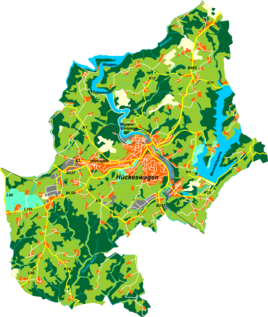Pixwaag
|
Pixwaag
City of Hückeswagen
Coordinates: 51 ° 9 ′ 9 ″ N , 7 ° 19 ′ 46 ″ E
|
||
|---|---|---|
| Height : | 318 m above sea level NN | |
| Postal code : | 42499 | |
| Area code : | 02192 | |
|
Location of Pixwaag in Hückeswagen |
||
Pixwaag , until 1644 Niederwaag , is a court in Hückeswagen in the Oberbergisches Kreis in the administrative district of Cologne in North Rhine-Westphalia ( Germany ).
Location and description
Pixwaag is located in western Hückeswagen near the main town, the settlement area of which has advanced to the town and has merged with the court. The Pixwaager Bach flows past the courtyard. Neighboring places are, in addition to the core town of Hückeswagen, the Schnabelsmühle , Erlensterz , Waag (formerly also called Oberwaag ), Wiehagen , Wiehagenerhöhe , Raspenhaus and Brunsbach .
The route of the disused railway line between Remscheid-Bergisch Born and Marienheide ( timetable KBS 412) separates Pixwaag from the Wupper pre-dam of the Wuppertal dam .
history
The Pixwaag farm was first mentioned as Waag in 1433 and was a saddle farm in the Middle Ages and early modern times , which was probably built to secure the old road from Remscheid via Hückeswagen to Wipperfürth and belonged to the ministers of the Hückeswagen counts . The saddle was originally at least 400 acres in size, but was expanded by splits such as B. downsized upper balance.
Around 1644 the bourgeois Pick acquired the Waag farm. The Pixwaag estate was named after them. The map Topographia Ducatus Montani from 1715 shows the courtyard as a picswag . In the 18th century the place belonged to the Bergisches Amt Bornefeld-Hückeswagen .
In 1815/16 there were 61 people living in the village. In 1832 Pixwaag belonged to the Berghauser Honschaft , which was part of the Hückeswagen external citizenship within the Hückeswagen mayor . The place, categorized as a hamlet according to the statistics and topography of the Düsseldorf administrative district , had five residential buildings and four agricultural buildings at that time. At that time, 71 people lived in the place, 39 Catholic and 32 Protestant faith.
In the municipality lexicon for the Rhineland province , ten houses with 136 inhabitants are given for 1885. At that time the place belonged to the rural community Neuhückeswagen within the Lennep district . In 1895 the place had nine houses with 158 inhabitants, in 1905 nine houses and 130 inhabitants.
Hiking and biking trails
The following hiking trails lead through the village:
- The local hiking trail △ from Elberhausen to the Goldenbergshammer
- The local ■ hiking trail from Kräwinklerbrücke to Hückeswagen center
literature
- Wilhelm Blankertz: Tewaag, its name, its farm and its history ( online )
Individual evidence
- ^ Johann Georg von Viebahn : Statistics and topography of the administrative district of Düsseldorf. Part 2: Containing the statistical table of places and distances and the alphabetical index of place names. Schreiner, Düsseldorf 1836, p. 13 .
- ^ Royal Statistical Bureau (Prussia) (Ed.): Community encyclopedia for the Rhineland province. Based on the materials from the census of December 1, 1885 and other official sources (= community encyclopedia for the Kingdom of Prussia. Vol. 12, ZDB -ID 1046036-6 ). Publishing house of the Royal Statistical Bureau, Berlin 1888.
- ^ Royal Statistical Bureau (Prussia) (Ed.): Community encyclopedia for the Rhineland province. Based on the materials from the census of December 1, 1895 and other official sources (= community encyclopedia for the Kingdom of Prussia. Vol. 12). Publishing house of the Royal Statistical Bureau, Berlin 1897.
- ^ Royal Statistical Bureau (Prussia) (Ed.): Community encyclopedia for the Rhineland province. Based on the materials from the census of December 1, 1905 and other official sources (= community encyclopedia for the Kingdom of Prussia. Vol. 12). Publishing house of the Royal Statistical Bureau, Berlin 1909.

